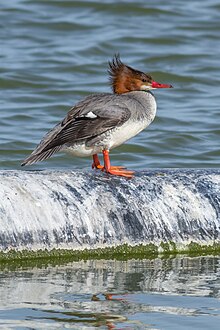Common Merganser
| Common merganser | |
|---|---|
 |
|
| M. m. merganser, male in Sandwell, England | |
 |
|
| M. m. merganser, female | |
| Scientific classification | |
| Kingdom: | Animalia |
| Phylum: | Chordata |
| Class: | Aves |
| Order: | Anseriformes |
| Family: | Anatidae |
| Subfamily: | Merginae |
| Genus: | Mergus |
| Species: | M. merganser |
| Binomial name | |
|
Mergus merganser Linnaeus, 1758 |
|
| Subspecies | |
|
3, see text |
|
 |
|
| M. merganser range Breeding range Year-round range Wintering range | |
| Synonyms | |
|
Merganser americanus Cassin, 1852 |
|
3, see text
Merganser americanus Cassin, 1852
The common merganser (North American) or goosander (Eurasian) (Mergus merganser) is a large duck of rivers and lakes in forested areas of Europe, northern and central Asia, and North America. The genus name is a Latin word used by Pliny and other Roman authors to refer to an unspecified waterbird, and merganser is derived from mergus and anser, Latin for "goose"
The common merganser eats fish and nests in holes in trees. John James Audubon also used the name "Buff-breasted Merganser" (in addition to "goosander") in his book The Birds of America.
It is 58–72 cm (23–28 in) long with a 78–97 cm (31–38 in) wingspan and a weight of 0.9–2.1 kg (2.0–4.6 lb); males average slightly larger than females but with some overlap. Like other species in the genus Mergus, it has a crest of longer head feathers, but these usually lie smoothly rounded behind the head, not normally forming an erect crest. Adult males in breeding plumage are easily distinguished, the body white with a variable salmon-pink tinge, the head black with an iridescent green gloss, the rump and tail grey, and the wings largely white on the inner half, black on the outer half. Females, and males in "eclipse" (non-breeding plumage, July to October) are largely grey, with a reddish-brown head, white chin, and white secondary feathers on the wing. Juveniles (both sexes) are similar to adult females but also show a short black-edged white stripe between the eye and bill. The bill and legs are red to brownish-red, brightest on adult males, dullest on juveniles.
There are three subspecies, differing in only minor detail:
Like the other mergansers, these fish-feeding ducks have serrated edges to their bills to help them grip their prey, so they are often known as "sawbills". In addition to fish, they take a wide range of other aquatic prey, such as molluscs, crustaceans, worms, insect larvae, and amphibians; more rarely, small mammals and birds may be taken. As in other birds with the character, the salmon-pink tinge shown variably by males is probably diet-related, obtained from the carotenoid pigments present in some crustaceans and fish. When not diving for food, they are usually seen swimming on the water surface, or resting on rocks in midstream or hidden among riverbank vegetation, or (in winter) on the edge of floating ice.
...
Wikipedia

